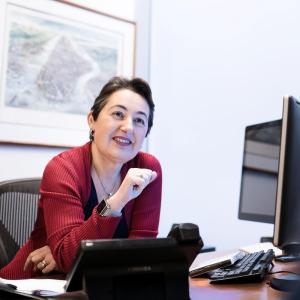Realigned Patient Management Enables Safe, Effective Care as New Insights Link Neurological Symptoms to Virus Outcomes

Clinicians in the Department of Neurology joined the multidisciplinary COVID-19 care teams comprising physicians and staff, including Diana Gorga, RN, across NYU Langone Health, working tirelessly to manage the influx of patients with COVID-19, as neurologists simultaneously uncovered evidence of COVID-19–related neurological complications that informed tailored approaches to patient management.
Photo: Jonathan Kozowyk
As the city of New York quickly became one of the country’s first coronavirus disease (COVID-19) epicenters, the continued delivery of quality healthcare depended on a rapid realignment of resources across NYU Langone Health. In neurology, we shifted to treating the sickest patients diagnosed with COVID-19, while inpatient and outpatient neurological care quickly pivoted to a telemedicine-based model. At the same time, pushing toward innovation, the team uncovered evidence pointing to neurological complications of COVID-19 and the critical role neurologists would play in effectively managing and treating patients with the virus.
With focused and flexible leadership, effective communication, and system-wide collaboration, the Department of Neurology contributed to positive outcomes for patients with COVID-19 while simultaneously maintaining continued quality in neurological care, research, and education.
Fighting a Novel Virus with Unprecedented Innovation
As patient units became overtaxed by patients diagnosed with the novel and unpredictable virus, the moment demanded an expeditious shift in our approach to the safe delivery of care, putting our flexibility and ingenuity to the test. “We experienced a complete transformation of our normal course of operations in a single week—it was a period of necessary adaptability and innovation at every level: clinical care, education, and research,” says Steven L. Galetta, MD, the Philip K. Moskowitz, MD, Professor and Chair of Neurology and professor of ophthalmology. “It quickly became clear that the battle would be won through innovation, and our team responded with inspiring resilience and compassion.”
“We experienced a complete transformation of our normal course of operations in a single week—it was a period of necessary adaptability and innovation at every level: clinical care, education, and research.”
—Steven L. Galetta, MD
Such innovation began with necessary shifts in patient management, with a significant number of department faculty and staff redeployed to inpatient units dedicated to the care of patients with COVID-19. “We organized ourselves as a team of individuals contributing to a larger mission,” notes Dr. Galetta. Small teams were created to treat patients with COVID-19 in rotating shifts. Staff were assigned specific focus areas to problem-solve the work–life challenges of such extraordinary shifts—wellness, transportation, and child care challenges among them—creating a division of labor and enabling streamlined department-wide communication.
As inpatient care centered on patients with COVID-19, outpatient neurological care shifted to telemedicine, with a rapid acceleration to complete more than 10,000 video visits over the course of 10 weeks. Studies published in June 2020 in Neurology and in September 2020 in the Journal of Neuro-Ophthalmology combine insights accumulated by the department to document best practices in the use of telemedicine for safe and effective delivery of remote neurological care. The studies note that a robust technology infrastructure and streamlined, sharable documentation and coding are key to performing virtual neurological examinations that are clinically meaningful. “Beyond the obvious safety benefits of video visits for patients in the context of COVID-19, for some patients with cognitive and movement disorders—for whom transportation and mobility are common challenges—this option has enabled them to be seen more easily for follow-up care,” says Dr. Galetta. “As a result, a hybrid of in-person and video visits is likely to become the standard for managing our patients over the long term.”
Emerging Evidence Uncovers Neurological Links in Severe COVID-19
The neurology team’s rapid redeployment to COVID-19 units was critical as the pandemic took hold. When patients with severe disease increasingly exhibited neurological complications, the deep insights of neurologists proved instrumental in discerning symptom patterns and adjusting care plans accordingly. In an analysis of nearly 4,500 admitted patients, neurological complications were seen in more than 800, with the most common abnormality being encephalopathy caused by metabolic disturbances. Stroke was observed in approximately 2 percent of hospitalized patients, likely due to the virus attacking the endothelial cells.
The team has documented some of its findings of neurological involvement in COVID-19 through published research. In a retrospective chart review published in August 2020 in Stroke, Dr. Galetta and colleagues reviewed brain MRIs in adult patients admitted to NYU Langone hospitals between March 1, 2020, and May 10, 2020. They compared clinical, laboratory, and functional outcomes of patients with findings of leukoencephalopathy, cerebral microbleeds, or both—thought to represent various combinations of arterial and venous occlusions coupled with hypoxia—versus patients without these findings. Of the patients who had a brain MRI, 30 percent were found to have leukoencephalopathy, cerebral microbleeds, or both, and the presence of these findings was associated with longer hospitalizations, increased mortality, and poorer functional outcomes at discharge.
A randomized clinical trial is underway at NYU Langone to formally study the effects of anticoagulation in patients critically ill with COVID-19, and the team now has more than 20 active research studies and published reports regarding the neurological effects of COVID-19—with several study grants already funded.
“All told, our findings point to an association between neurological complications of COVID-19 and severe illness,” notes Dr. Galetta. “They could provide insight into the pathophysiology of brain damage and encephalopathy observed in this disease as we continue to understand the role of anticoagulation, steroids, and other drugs that can improve treatment and neurological outcomes for COVID-19 patients.”
Probing a Pandemic’s Impact on Psychosocial Wellness
Another body of research elucidated an area of shared concern for the department since the start of the pandemic: psychosocial wellness. In early May 2020, Dr. Galetta and colleagues administered an anonymous electronic survey to all neurology faculty and staff to assess their psychosocial concerns and the effectiveness of department initiatives to mitigate the impact of the pandemic on psychosocial wellness. Among 130 survey respondents, substantial proportions of both faculty and staff self-reported having increased fear (79 percent), anxiety (83 percent), and depression (38 percent) during the COVID-19 pandemic. The research, published in July 2020 in the Journal of Neurological Sciences, captures the emotional wellness impacts of a provider community at an historic crisis point, underscoring the importance of practitioner wellness both during and beyond the pandemic. The respondents also reported that NYU Langone had provided adequate emotional support and counseling.
Within the Department of Neurology, a range of initiatives focused on employee wellness were recommended and adopted, from virtual social gatherings to conference rooms converted to spaces for therapy sessions. “The pandemic has impacted the lives and minds of our providers,” notes Dr. Galetta. “Efforts to support our providers through the evolving crisis have been imperative to promote the resilience we need to care for our patients.”
Created Through Crisis, Innovations Worth Sustaining
Many of the practices initiated throughout the department as the virus first took hold may have a permanent place in specialty best practices moving forward, well beyond the prospect of a second wave of infection that may yet loom. In addition to the benefits of telemedicine for neurologically complex patients, other COVID-19 innovations—such as virtual education events that enabled Department of Neurology faculty to meet conference commitments throughout the pandemic—could be adopted for greater efficiency and enhanced information sharing within the specialty.
“I think what we’ve done will become an integral component of our ability to communicate,” notes Dr. Galetta. “You don’t need to travel to be connected to an educational experience you might have missed because you couldn’t get to a certain city or medical center.” Such a shift could lessen the regionalization of medical education, both internally and externally, Dr. Galetta adds.
“Suddenly internally, everyone can come to grand rounds, and externally you can transmit your educational experience nationwide,” he says. “These were necessary innovations that ultimately can contribute to our larger mission: enhancing quality care for the sake of our patients.”

